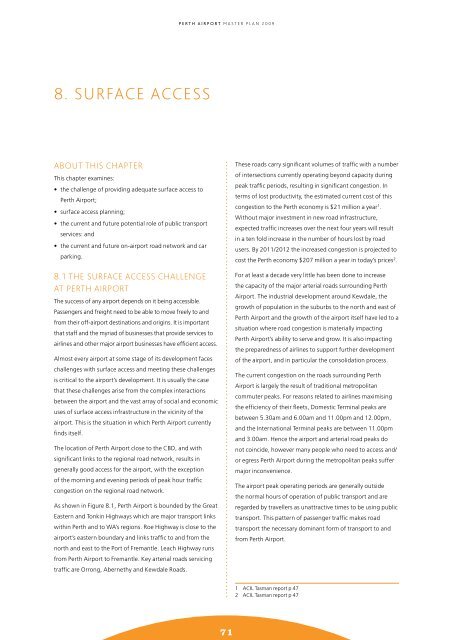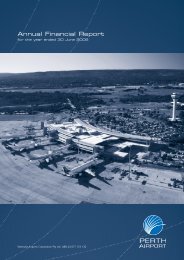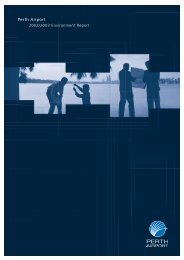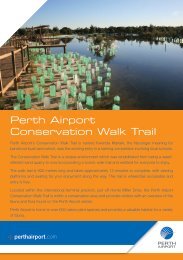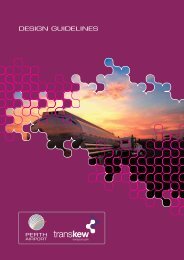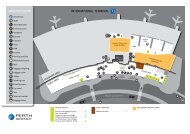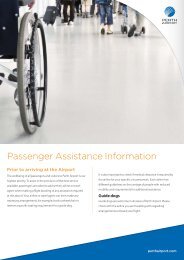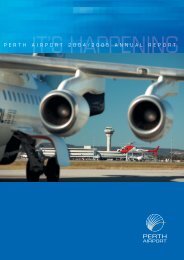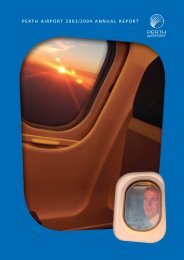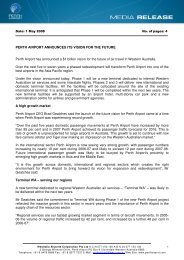PERTH AIRPORT Master Plan 2009
PERTH AIRPORT Master Plan 2009
PERTH AIRPORT Master Plan 2009
You also want an ePaper? Increase the reach of your titles
YUMPU automatically turns print PDFs into web optimized ePapers that Google loves.
P E R T H A I R P O R T M a s t e r P l a n 2 0 0 9<br />
8. Surface Access<br />
About this Chapter<br />
This chapter examines:<br />
• the challenge of providing adequate surface access to<br />
Perth Airport;<br />
• surface access planning;<br />
• the current and future potential role of public transport<br />
services: and<br />
• the current and future on-airport road network and car<br />
parking.<br />
8.1 The Surface Access Challenge<br />
at Perth Airport<br />
The success of any airport depends on it being accessible.<br />
Passengers and freight need to be able to move freely to and<br />
from their off-airport destinations and origins. It is important<br />
that staff and the myriad of businesses that provide services to<br />
airlines and other major airport businesses have efficient access.<br />
Almost every airport at some stage of its development faces<br />
challenges with surface access and meeting these challenges<br />
is critical to the airport’s development. It is usually the case<br />
that these challenges arise from the complex interactions<br />
between the airport and the vast array of social and economic<br />
uses of surface access infrastructure in the vicinity of the<br />
airport. This is the situation in which Perth Airport currently<br />
finds itself.<br />
The location of Perth Airport close to the CBD, and with<br />
significant links to the regional road network, results in<br />
generally good access for the airport, with the exception<br />
of the morning and evening periods of peak hour traffic<br />
congestion on the regional road network.<br />
As shown in Figure 8.1, Perth Airport is bounded by the Great<br />
Eastern and Tonkin Highways which are major transport links<br />
within Perth and to WA’s regions. Roe Highway is close to the<br />
airport’s eastern boundary and links traffic to and from the<br />
north and east to the Port of Fremantle. Leach Highway runs<br />
from Perth Airport to Fremantle. Key arterial roads servicing<br />
traffic are Orrong, Abernethy and Kewdale Roads.<br />
These roads carry significant volumes of traffic with a number<br />
of intersections currently operating beyond capacity during<br />
peak traffic periods, resulting in significant congestion. In<br />
terms of lost productivity, the estimated current cost of this<br />
congestion to the Perth economy is $21 million a year 1 .<br />
Without major investment in new road infrastructure,<br />
expected traffic increases over the next four years will result<br />
in a ten fold increase in the number of hours lost by road<br />
users. By 2011/2012 the increased congestion is projected to<br />
cost the Perth economy $207 million a year in today’s prices 2 .<br />
For at least a decade very little has been done to increase<br />
the capacity of the major arterial roads surrounding Perth<br />
Airport. The industrial development around Kewdale, the<br />
growth of population in the suburbs to the north and east of<br />
Perth Airport and the growth of the airport itself have led to a<br />
situation where road congestion is materially impacting<br />
Perth Airport’s ability to serve and grow. It is also impacting<br />
the preparedness of airlines to support further development<br />
of the airport, and in particular the consolidation process.<br />
The current congestion on the roads surrounding Perth<br />
Airport is largely the result of traditional metropolitan<br />
commuter peaks. For reasons related to airlines maximising<br />
the efficiency of their fleets, Domestic Terminal peaks are<br />
between 5.30am and 6.00am and 11.00pm and 12.00pm,<br />
and the International Terminal peaks are between 11.00pm<br />
and 3.00am. Hence the airport and arterial road peaks do<br />
not coincide, however many people who need to access and/<br />
or egress Perth Airport during the metropolitan peaks suffer<br />
major inconvenience.<br />
The airport peak operating periods are generally outside<br />
the normal hours of operation of public transport and are<br />
regarded by travellers as unattractive times to be using public<br />
transport. This pattern of passenger traffic makes road<br />
transport the necessary dominant form of transport to and<br />
from Perth Airport.<br />
1 ACIL Tasman report p 47<br />
2 ACIL Tasman report p 47<br />
71


